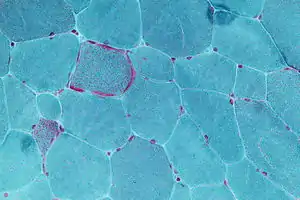Mitochondrial myopathy
Mitochondrial myopathies are types of myopathies associated with mitochondrial disease.[1] On biopsy, the muscle tissue of patients with these diseases usually demonstrate "ragged red" muscle fibers. These ragged-red fibers contain mild accumulations of glycogen and neutral lipids, and may show an increased reactivity for succinate dehydrogenase and a decreased reactivity for cytochrome c oxidase. Inheritance was believed to be maternal (non-Mendelian extranuclear). It is now known that certain nuclear DNA deletions can also cause mitochondrial myopathy such as the OPA1 gene deletion. There are several subcategories of mitochondrial myopathies.
| Mitochondrial myopathy | |
|---|---|
.svg.png.webp) | |
| Simplified structure of a typical mitochondrion | |
| Specialty | Neurology |
Signs and symptoms
Signs and symptoms include (for each of the following causes):
- Mitochondrial encephalomyopathy, lactic acidosis, and stroke-like syndrome (MELAS)
- Varying degrees of cognitive impairment and dementia
- Lactic acidosis
- Strokes
- Transient ischemic attacks
- Hearing loss
- Weight loss
- Myoclonic epilepsy and ragged-red fibers (MERRF)
- Progressive myoclonic epilepsy
- Clumps of diseased mitochondria accumulate in muscle fibers and appear as "ragged-red fibers" when muscle is stained with modified Gömöri trichrome stain
- Short stature
- Kearns–Sayre syndrome (KSS)
- External ophthalmoplegia
- Cardiac conduction defects
- Sensorineural hearing loss
- Chronic progressive external ophthalmoplegia (CPEO)
- Progressive ophthalmoparesis
- Symptomatic overlap with other mitochondrial myopathies
Cause
Zidovudine, an HIV medication can cause red ragged fiber myopathy.
Diagnosis

Muscle biopsy: ragged red fibers in Gömöri trichrome stain.
Treatment
Although no cure currently exists, there is hope in treatment for this class of hereditary diseases with the use of an embryonic mitochondrial transplant.[2]
References
- "Mitochondrial Myopathy Information Page | National Institute of Neurological Disorders and Stroke". www.ninds.nih.gov. Retrieved 2017-02-28.
- "Three-parent embryo formed in lab" (web). Scientists believe they have made a potential breakthrough in the treatment of serious disease by creating a human embryo with three separate parents. BBC News. 5 February 2008. Retrieved 2008-02-08.